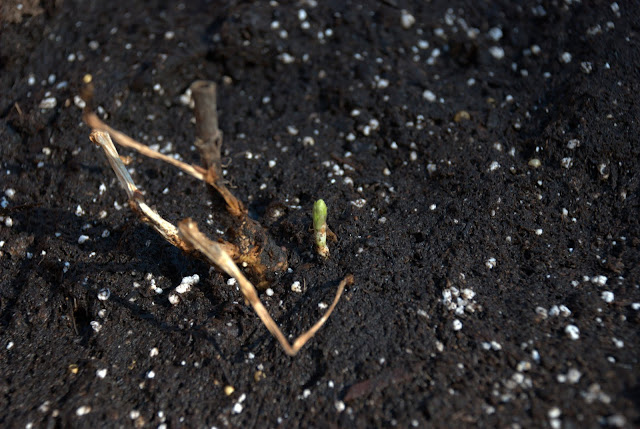When I was extract brewing, I couldn't totally tell you because everything was somewhat expensive. The malt extract itself was probably one of the more expensive things. Now that I'm all-grain brewing, grain typically costs me around $1.15 to $1.60. A normal 5gal batch runs around 12lbs of grain. Hops runs around $3.50/oz or more with the typical beer using 2 oz and the IPA's running up to 9+oz. Going back to my families farming roots, I figured this year I'd grow my own hops. Not only as a cost saver, but once again having even more pride in what I made. Remember, I always tell people not to brew to save money, but brew to have pride in what you created.
This spring I pre-ordered 6 hop plants, called rhizomes, and knew that I was going to be getting some extras from my buddy Paul. There was a bit of mis-communication between myself and the mrs about where exactly I was planning on planting these hops. It was pre-agreed that my in-laws wanted some plants to grow on an old dog kennel, but that wasn't going to be all of the plants. My mom sparked some interest in growing some hops at her place. Perfect, now I've got my homes.
I planted 3 of them at the In-laws: Golding, Hallertau, and Centennial. Apparently I planted them too deep as all 3 of them rotted out and died. I fail. I'm too embarrassed to show the pictures.
I gave 3 of them to my mom: Tettnang, Fuggle, and Nugget. She did **not** fail. Here's some pictures from a little over a week ago:
I love the planter box
And here's one from a few days ago:
That's awesome. I know first year hops don't produce much and these were planted only about 3 weeks ago, but I'm stoked for anything I can get off them. Now, some of my friends and fellow brewers have crazy plants already. Some examples:
Paul's hops from 2 weeks ago. These are 2nd and 3rd year hops if I remember correctly:
Also an old highschool classmate of mine is growing his own hops. Check out Aaron's blog here. Here's a stolen picture from his blog:
Now, with all these people growing awesome hops, I still had a cascade rhizomes sitting in my fridge from Paul. I went to home depot two weeks ago and picked up a planter so that I could start growing it. Here it is today:
Now I know it doesn't look like much, but I'm pretty excited because this little guy has had a ruff life. It's been attacked by animals, twice, which left it uprooted. It also sat in my fridge for well over 2 months. With that little vine sticking up I know it should take off. I don't expect anything out of it this year, but hopefully next year I'll get a nice amount of hops off it.
Grandpa Giles Honey Wheat Update:
So, as hopefully you all read my last post about my crazy honey wheat which has my hands full, figured I'd give you a little update. My house smells like a brewery. I LOVE IT! Now, from time to time I've had it where I've got a little smell of the brewery when I walk right by the fermentor, but this time the second I walked into the house I could smell it. The smell has gone down a little, but it's still there in the basement. The airlock bubbling has gone down a lot as I'm now on day 3 of fermenting. The first few days are the strongest, then it starts to go down near the end of day 2. Hopefully I didn't contaminate the beer at all.
I'm going to do a new segment on my blogs. I plan on writing what beer I'm drinking while writing, if any, and my notes on it. So, for this blog I've been drinking Southern Tier Hopsun Seasonal. They advertise it as a summer wheat beer with 1 variety of hops (doesn't say which hop, but my guess is cascade) and 3 types of malts (my guess, your typical 2-row base malt, a wheat, and a low number crystal malt, maybe 20). For a wheat beer it has a pretty aggressive IBU, which is somewhat expected given the name. I personally don't know if I'd classify it as a summer beer as my idea of summer beers are very easy drinkers. This is more of an IPA, which can pack more of a punch in your mouth then wanted on a hot summer day. Now IPA fans don't get all butthurt, I love the IPA just like everyone else. I'm just saying on real hot days I enjoy something a little easier on the mouth then a 60+ IBU beer.
Prost!
-Ryan







